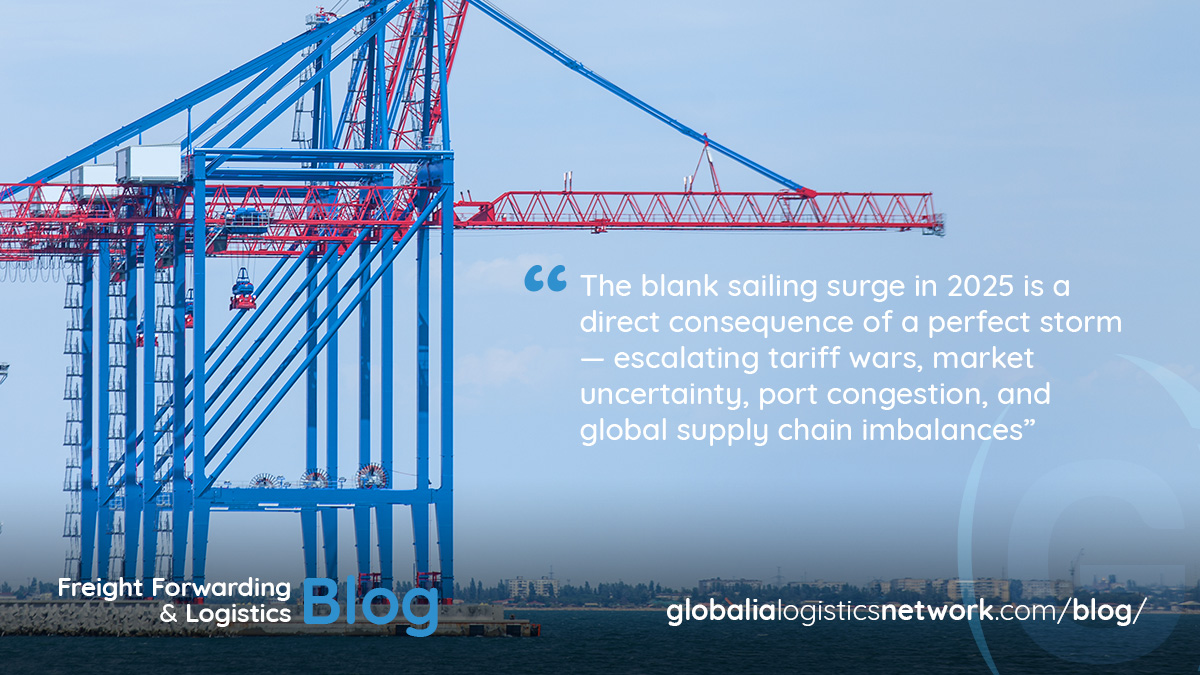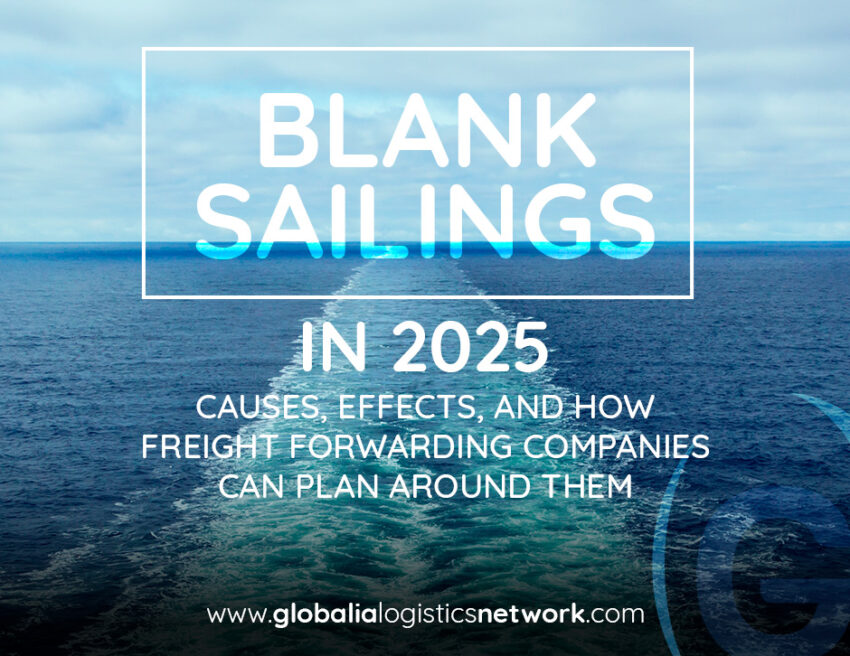The shipping industry in 2025 is facing a turbulent wave that freight forwarding companies must understand and adapt to — blank sailings. These canceled voyages, once an occasional adjustment, have surged dramatically, reshaping global supply chains, especially along the crucial Trans-Pacific routes connecting Asia and North America.

But why the sudden spike? What does this mean for sea freight forwarding companies, shippers, and the broader economy? More importantly, how can forwarders effectively plan around these disruptions to keep goods moving smoothly? Let’s unpack the causes, consequences, and strategies in detail.
Why the Sudden Surge in Blank Sailings?
The root of this escalating trend can be traced back primarily to the renewed US-China tariff conflict. The trade war has reignited with a vengeance, marked by staggering tariffs on both sides — reports cite as high as 145% US tariffs on some Chinese goods, met by retaliatory Chinese tariffs around 125%. These unprecedented trade barriers have disrupted the usual flow of goods, making it harder for businesses and shipping lines to predict volumes and plan accordingly.
On top of that, the extreme uncertainty surrounding tariff policies compounds the problem. Shippers and carriers alike are caught in a cycle of constant change, with tariff rates and regulations shifting almost weekly. This lack of stability makes it nearly impossible for shipping lines to commit to fixed schedules or capacity, fueling the rise in blank sailings as carriers try to avoid sailing half-empty vessels.
What’s Happening? A Surge in Cancellations
The Trans-Pacific shipping lanes are currently the epicenter of this disruption. Blank sailings on these routes have exploded in recent weeks — entire container ship voyages are being scrapped wholesale.
To put it into perspective, planned blank sailing capacity (measured over a rolling four-week window) surged from around 60,000 TEUs to a staggering 367,800 TEUs — that’s a 600% increase in just three weeks (referencing the latest Sea-Intelligence data). This massive spike isn’t just a statistic; it represents a profound tightening of available space for freight forwarding companies trying to secure slots for their clients’ shipments.
Impact on Shipping & Logistics: A Market in Crisis
This dramatic reduction in sailing capacity is wreaking havoc on global shipping and logistics.
-
Capacity Shrinks Significantly: On the Asia–North America West Coast route, weekly shipping capacity dropped by 12% in just six weeks, falling from 1.43 million TEUs to 1.37 million TEUs. The East Coast route experienced an even sharper decline of 14%, dropping from 1.01 million TEUs to 867,000 TEUs.
-
Reliability Concerns: Shipping analysts like Drewry predict schedule reliability at around 90% for the next five weeks but warn that continued blank sailings could push this lower, jeopardizing timely deliveries.
-
Port Operations Under Stress: The ripple effects extend into port infrastructure. U.S. ports, especially Los Angeles and Long Beach, are struggling with congestion and chaos. Cargo volumes are volatile as businesses reroute shipments to avoid tariffs, overwhelming port capacity. Delays for unloading have stretched to 7-10 days, creating bottlenecks that cascade into the entire supply chain.
-
Rising Logistics Costs: Port congestion and delays have forced warehouse rental prices near key ports to skyrocket by over 30% in just one month, according to recent Reuters surveys — a clear indication of how blank sailings inflate costs beyond just shipping fees.
-
Manufacturing Challenges in China: Factories, especially in export hubs like Yiwu, are experiencing order cancellations and inventory buildup. Some small and medium enterprises (SMEs) face closures or difficulties meeting payroll, with estimates that up to 30% of China’s export-dependent SMEs are at risk due to this disruption.
-
Retail Sector Strain: Major retailers like Nike and Best Buy are bracing for higher costs as tariffs raise import prices, which will inevitably pass on to consumers. Stock shortages due to shipping delays hit sales cycles hard, particularly for seasonal products. Amazon’s cancellation of summer orders highlights how supply uncertainty affects inventory planning.
-
Wider Economic Impact: The instability also affects agriculture, energy sectors, and domestic transportation networks. For example, companies like UPS have reported revenue drops linked to reduced port throughput and freight volumes, showing how blank sailings disrupt trucking and rail sectors connected to maritime logistics.
-
Volatile Freight Rates: Although reduced capacity would usually drive prices up, fluctuating demand has created instability. For instance, Drewry’s World Container Index fell 3% in mid-April 2025, reflecting the unpredictable market conditions freight forwarding companies must navigate.
Beyond Shipping: The Broader Economic Shockwaves
The consequences of blank sailings ripple far beyond ports and shipping lanes, affecting entire industries and economies:
-
Manufacturing Challenges in China: Factories, especially in export hubs like Yiwu, are experiencing order cancellations and inventory buildup. Some small and medium enterprises (SMEs) face closures or difficulties meeting payroll, with estimates that up to 30% of China’s export-dependent SMEs are at risk due to this disruption.
-
Retail Sector Strain: Major retailers like Nike and Best Buy are bracing for higher costs as tariffs raise import prices, which will inevitably pass on to consumers. Stock shortages due to shipping delays hit sales cycles hard, particularly for seasonal products. Amazon’s cancellation of summer orders highlights how supply uncertainty affects inventory planning.
-
Wider Economic Impact: The instability also affects agriculture, energy sectors, and domestic transportation networks. For example, companies like UPS have reported revenue drops linked to reduced port throughput and freight volumes, showing how blank sailings disrupt trucking and rail sectors connected to maritime logistics.
How Freight Forwarding Companies Can Plan Around Blank Sailings
For freight forwarding companies, blank sailings present both a challenge and an opportunity — the ability to adapt quickly will define success in 2025. Here are key strategies to consider:
1. Monitor Market Signals and Develop Carrier Partnerships
Keeping close tabs on blank sailing announcements and cultivating strong carrier relationships enables early insight into capacity shifts. Forwarders with better intel can secure bookings before capacity tightens.
2. Diversify Routes and Modes
Relying solely on the Trans-Pacific shipping lanes is risky. Freight forwarding companies should explore alternative routes and transshipment hubs, consider rail or air freight options for critical shipments, and adopt a multimodal mindset to ensure flexibility.
3. Invest in Real-Time Visibility and Analytics
Digital platforms providing live updates on vessel schedules, port congestion, and booking statuses help freight forwarders make informed decisions quickly. Predictive analytics also allow anticipation of demand surges or declines tied to tariff changes.
4. Communicate Transparently with Clients
Proactive and transparent client communication regarding potential delays or increased costs builds trust. Freight forwarders who explain blank sailing impacts and their mitigation efforts stand out as reliable partners.
5. Build Schedule Buffers
Advising clients to plan shipments with flexible timelines and buffer periods can reduce last-minute crises caused by sudden sailing cancellations.
6. Negotiate Contractual Flexibility
Incorporating clauses that allow for changes in shipping schedules or capacity commitments helps freight forwarding companies and clients share risk more effectively amid uncertainty.
Final Thoughts: Thriving Amid Uncertainty
The blank sailing surge in 2025 is a direct consequence of a perfect storm — escalating tariff wars, market uncertainty, port congestion, and global supply chain imbalances. For freight forwarding companies, the stakes are high but manageable with the right strategy.
By staying informed, embracing technology, and fostering strong relationships with carriers and clients, freight forwarders can navigate the choppy waters of blank sailings. Flexibility, transparency, and strategic planning are the keys to not just surviving but thriving during these turbulent times.
Understanding the cause-and-effect relationship of blank sailings and integrating these insights into everyday operations will position freight forwarding companies as indispensable partners in global trade — capable of turning disruption into opportunity in 2025 and beyond.


